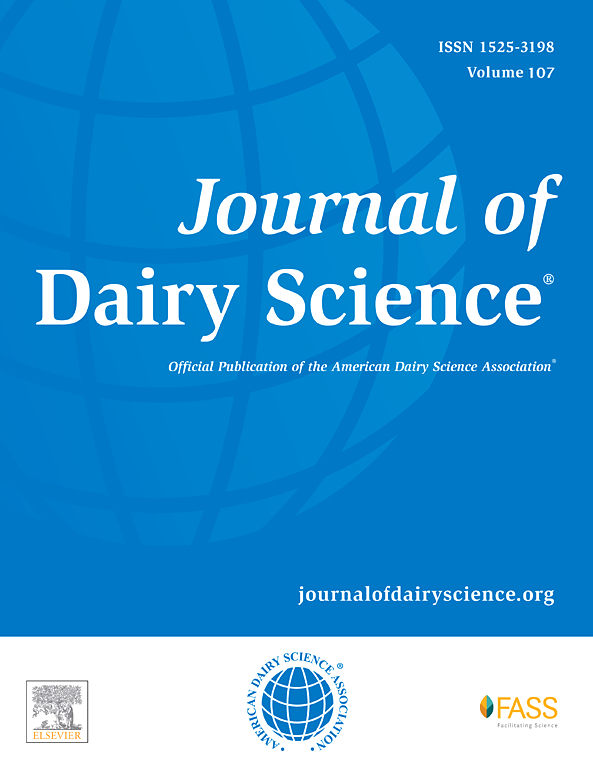Effects of frozen storage time on bovine serum and plasma concentrations of macrominerals and indicators of energy balance
IF 3.7
1区 农林科学
Q1 AGRICULTURE, DAIRY & ANIMAL SCIENCE
引用次数: 0
Abstract
Concentrations of macrominerals and markers of energy balance are often determined in samples that have been stored frozen for a period of time. The objective of this study was to compare concentrations of Ca, P, Mg, nonesterified fatty acids (NEFA), and BHB determined in serum and plasma samples after separation of whole blood within 24 h of collection (fresh sample) and after storage at −18°C for 3 or 6 mo. Nonhemolyzed blood samples collected into lithium heparin or nonadditive tubes from 76 dairy cows at 21 ± 9 d postpartum (mean ± SD) were used in this study. Serum or plasma was harvested into separate aliquots within 6 h of sample collection for testing as fresh (stored at 4°C until testing within 24 h of sample collection; baseline) or after 3 or 6 mo of storage at −18°C on a wet chemistry analyzer. We observed effects of sample type (serum vs. plasma) on P, Mg, and NEFA concentrations and effects of storage time (0 vs. 3 or 6 mo) on Ca, P, Mg, NEFA, and BHB concentrations. In addition, effects of storage time were conditional to the sample type for P and BHB concentrations. Effects of sample type and storage for up to 3 mo were minimal, potentially biologically and diagnostically irrelevant for all the evaluated analytes. However, storage for 6 mo may have relevant effects on Ca, P, and BHB concentrations. Compared with baseline, the Ca concentration after 6 mo of storage was 0.27 mmol/L less (95% CI = −0.31 to −0.22 mmol/L). Phosphorus and BHB concentrations were significantly less after 6 mo of storage, but the difference varied according to sample type (in mmol/L; P: −0.11 [95% CI = −0.30 to −0.25] in serum and −0.06 [95% CI = −0.26 to −0.21] in plasma; BHB: −0.27 [95% CI = −0.36 to −0.18] in serum and −0.18 [95% CI = −0.23 to −0.13] in plasma). In conclusion, the effects of sample type and storage for up to 3 mo at −18°C were minimal, but the potential effects of longer durations of frozen storage on concentrations of Ca, P, and BHB should be considered. Further research is needed to corroborate findings from this study and to describe optimum storage conditions for samples when timely testing is not feasible.
冷冻贮藏时间对牛血清和血浆宏观矿物质浓度及能量平衡指标的影响。
宏观矿物质的浓度和能量平衡的标志通常是在冷冻储存一段时间的样品中测定的。本研究的目的是比较全血分离后采集24小时内(新鲜样本)和-18°C保存3或6个月后血清和血浆样品中Ca、P、Mg、非酯化脂肪酸(NEFA)和BHB的浓度。本研究使用76头奶牛产后21±9 d(平均值±标准差)未溶血的血液样本,这些血液样本被采集到肝素锂或非添加剂管中。采集血样后6小时内将血清或血浆分装成单独的等份,作为新鲜样品进行检测(在4°C保存,直到采集血样后24小时内进行检测;基线),在-18°C的湿化学分析仪上保存3或6个月后。我们观察了样品类型(血清和血浆)对P、Mg和NEFA浓度的影响,以及储存时间(0 vs 3或6个月)对Ca、P、Mg、NEFA和BHB浓度的影响。此外,P和BHB浓度的储存时间对样品类型的影响有条件。样品类型和储存长达3个月的影响很小,对所有评估的分析物可能在生物学和诊断上无关。然而,储存6个月可能对钙、磷和BHB浓度有相关影响。与基线浓度相比,Ca浓度降低0.27 mmol/L(95%可信区间(CI) = -0.31 ~ -0.22 mmol/L)。贮藏6个月后,磷和BHB浓度显著降低,但因样品类型不同而有差异[mmol/L];血清P: -0.11 (95% CI = -0.30 ~ -0.25),血浆P: -0.06 (95% CI = -0.26 ~ -0.21);血清BHB: -0.27 (95% CI = -0.36 ~ -0.18),血浆BHB: -0.18 (95% CI = -0.23 ~ -0.13)。综上所述,样品类型和在-18°C下保存3个月的影响很小,但应考虑较长冷冻保存时间对Ca, P和BHB浓度的潜在影响。需要进一步的研究来证实本研究的发现,并在无法进行及时检测时描述样品的最佳储存条件。
本文章由计算机程序翻译,如有差异,请以英文原文为准。
求助全文
约1分钟内获得全文
求助全文
来源期刊

Journal of Dairy Science
农林科学-奶制品与动物科学
CiteScore
7.90
自引率
17.10%
发文量
784
审稿时长
4.2 months
期刊介绍:
The official journal of the American Dairy Science Association®, Journal of Dairy Science® (JDS) is the leading peer-reviewed general dairy research journal in the world. JDS readers represent education, industry, and government agencies in more than 70 countries with interests in biochemistry, breeding, economics, engineering, environment, food science, genetics, microbiology, nutrition, pathology, physiology, processing, public health, quality assurance, and sanitation.
 求助内容:
求助内容: 应助结果提醒方式:
应助结果提醒方式:


